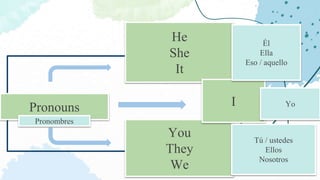
1. Presente continuo (5).pptx
- 1. He She It Pronouns You They We I Él Ella Eso / aquello Yo Tú / ustedes Ellos Nosotros Pronombres
- 2. Verb to be is / is not are / are not am / am not The negative form can also be written like: Is / Isn’t Are / aren’t Verbo ser / estar
- 3. Él está ocupado. Ella es linda. Eso está bien. Subjet + Verb to be + complement sujeto + verbo ser / estar + complemento He is bussy. She is cute. It is fine. You are awesome. They are cool. We are great. I am fine. How do we form sentences with verb to be? ¿Cómo formamos oraciones con el verbo ser o estar? Yo estoy bien. Tú estás ocupado. Ellos están geniales. Nosotros estamos bien.
- 4. ¿Cuándo utilizamos el presente continuo? Lo utilizamos para hablar sobre cosas que están pasando en el momento. Present continuous. When do we use present countinuous? We use present continuous to talk about things that are happening at the moment. I am teaching english. What am I doing right now? presente continuo ¿Qué estoy yo haciendo ahora? Yo estoy enseñando inglés.
- 5. For verbs that end in E remove E and add –ing. Example: - make / making - Write / writing For verbs that end in two consonant add –ing. Example: - help / helping - work / working For verbs that end in consonant + vowel + consonant double the consonant at the end and add –ing. Example: - stop / stopping - get / getting Rule III Rule I How do we form the present continuous? Rule II Subjetc + verb to be + verb.ing + complement. Para verbos que terminan en E quitamos la E y añade –ing Ejemplo: - Hacer / haciendo - Escribir / escribiendo Para verbos que term consonante + vocal + c dobla la consonante final ing Ejemplo: - Parar / parando - Obtener / obteniendo Para verbos que terminan en dos consonantes añade –ing Ejemplo: - Ayudar / ayudando - Trabajar / trabajando
- 6. For verbs that end in IE change IE to Y and add –ing. Example: - lie / lying - tie / tying For verbs that end in Y, X, W and others add –ing. Example: - Play / playing - Catch / catching Rule VI Rule IV Subjetc + verb to be + verb.ing + complement. Para verbos que terminan en IE cambia el IE por Y y añade –ing Ejemplo: - Mentir / mintiendo - Amarrar / Amarrando Para verbos que terminan en Y, X, W y otros añade –ing Ejemplo: - Jugar / jugando - Atrapar / atrapando For verbs that end in two volwels and a consonant add –ing. Example: - need / needing - wait / waiting Rule V Para verbos que terminan en vocales y consonante añade –in Ejemplo: - Necesitar / necesitando - Esperar / esperando
- 7. Rule V Rule IV Subjetc + verb to be + verb.ing + complement. Rule I Rule II Rule III He’s making food. He’s getting nervous. She’s helping people. They’re lying with that story. I’m waiting the buss. Él está haciendo comida. Él se está poniendo nervioso. Ella está ayudando personas. Ellos están mintiendo con esa historia Yo estoy esperando el bus.
- 8. THE END